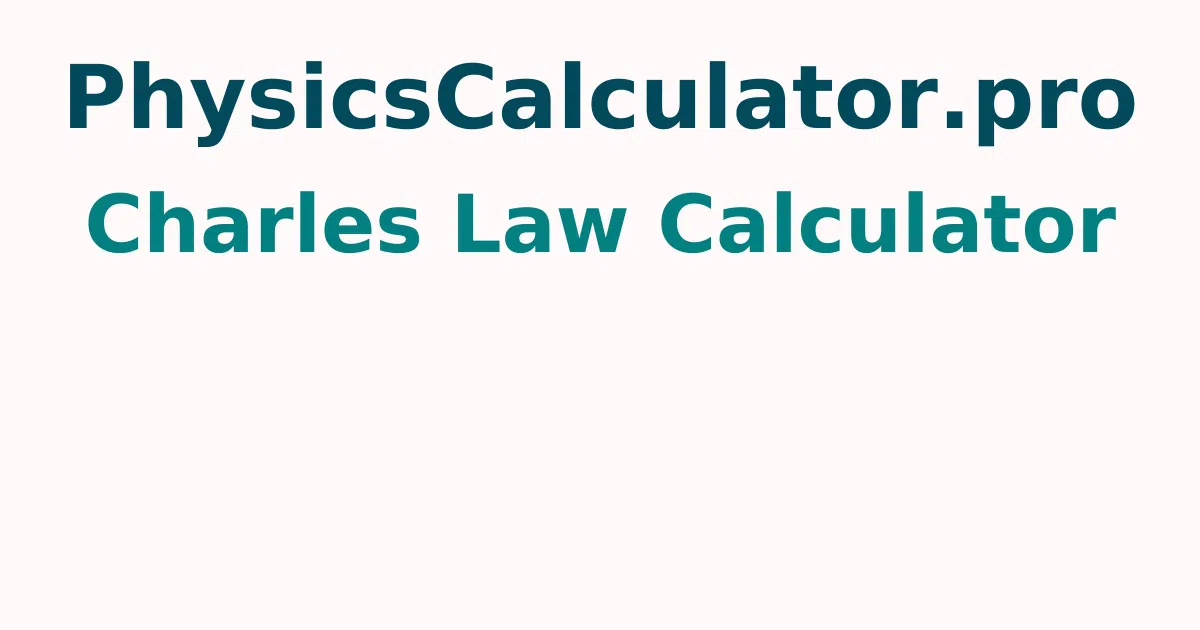Charles Law Calculator
The Charles Law Calculator is a web-based tool for determining the ideal gas characteristics in an isobaric reaction. All you have to do is enter the required inputs in the tool's input area and press the calculate button to get the output, which is the final pressure or volume, in no time.
Charle's Law Definition
When the mass and pressure of a gas remain constant, Charle's Law, commonly known as the Law of Volumes, describes the relationship between volume and temperature. Volume and temperature are exactly related, according to Charles Law.
In the other words, the Charles Law Definition can be rephrased as follows: The ratio of volume and temperature of a gas in a closed system remains constant as long as the pressure does not change. It describes the behaviour of an ideal gas in an isobaric transition, implying that the pressure remains constant throughout.
For more concepts check out physicscalculatorpro.comto get quick answers by using this free tool.
Charle's Law Formula
We can write the equation as V 1/ T 1= V 2/ T 2, where V 1and T 1are the initial volume and temperatures, and V2, T2 are the end values, according to the definition of Charles Law.
If you wish to calculate the ultimate volume, use the Charles Law Equation V 2= V 1/ T 1* T 2. On the other hand, rearranging the charles law formula yields T 2= T 1/ V 1* V 2if you wish to specify the ultimate volume and estimate the temperature.
Charle's Law Derivation
According to Charles Law, the volume of a gas is directly proportional to its temperature at constant pressure. The statement is abbreviated as VT. We can substitute a constant k for the proportionality sign, i.e. V/T = Constant = k. The Constant k is affected by the gas's pressure, as well as the amount, volume units, and other factors.
If we consider V 1and T 1to represent the original volume and temperature at constant pressure, we can write the equation as V 1/T 1=k .................(1)
When the temperature changes, the volume changes to V2 and the temperature changes to T2. The equation can be written as V 2/ T 2= k ................... (2)
V 1/ T 1= V 2/ T 2or V 1T 2=V 2T 1is the result of equating both equations.
Charles Law Graph
Isobar or Isoplestics is a graph of volume and temperature with constant pressure that always gives a straight line. For the temperature - 273.15°C, which is the lowest allowable temperature, a plot of V Versus T under constant pressure is presented below.
Examples of Charles Law in Reality | Charle's Law Applications
There are a variety of Charles Law applications, and we've listed the most popular ones in the areas below.
Balloon Flight:Have you ever watched a balloon fly across the sky and wondered how it got there? It's due to Charles Law, i.e. When air is heated, its volume expands and its density falls. The Bouyancy of Surrounding takes care of the rest, and the balloon begins to float.
Experiments with Liquid Nitrogen:When you place a balloon in a container filled with liquid nitrogen, it begins to shrink and liberate itself, regardless of how it was at the start. After a temperature change, it returns to its previous state, and so on.
Charle's Law Calculation Example
Question 1:The initial volume of a gas sample is 30L, and the initial temperature is -35°C. If the volume of the gas is 20L, what will the temperature be?
Solution:
Consider the problem, we have
Initial Volume (V 1)=30L
Converting Volume 30L into Cubic metres
Given, Volume v 1=30L
Volume V 1 =30 /1000 m 3
Volume V 1 =0.03 m 3
Final Volume(V 2 ) = 20L
Converting Volume 20L into Cubic metres
Given, Volume V 2 =20L
Volume V 2 =20 /1000 m 3
Volume V 2=0.02 m 3
Initial Temperature (T 1) = -35°C
Converting Volume 20lt into Cubic metres
Given Volume V 2 =20lt
Volume V 2 =20 /1000 m 3
Volume V 2 =0.02 m 3
We know the formula to calculate Charle's Law, V 1 / T 1 = V 2 / T 2
Substituting the inputs, we get the unknown parameter as
Temperature T 2 =(0.02*308.15)/0.03
Temperature T 2 =205.433K
As a result,The Temperature T 2 =205.433K
FAQs on Charles Law Calculator
1. What exactly does Charles Law entail?
The volume of a gas with a fixed mass is exactly proportional to temperature, according to Charles Law.
2. What are the Impacts of the Charles Law?
Balloon Flight, Liquid Nitrogen Experiments, Thermometers, and a variety of thermodynamic processes all require Charles Law.
3. What is the Charles Law Formula?
The equation V 1/T 1= V 2/T 1is the formula for Charles Law.
4. What is the Charles Law Calculator and how can I use it?
To figure out the other unknown parameter in the charles equation, simply enter the initial volume, temperature, and final volume or temperature, then press the calculate button.
